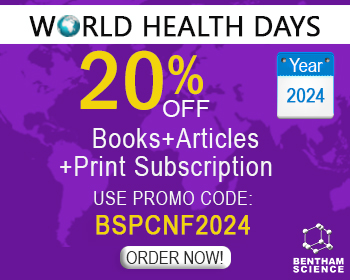Abstract
Background: Honey is a sweet and flavorful natural product that comes from a lot of nectar of medicinal plants.
Objective: This study aimed to determine the botanical origin, physicochemical parameters, antioxidant contents, and antibacterial activities of Algerian honey.
Methods: The physicochemical parameters of the honey analyzed were measured using the methods established by the European Honey Commission. The antioxidant contents were determined using colorimetric assays, and the antioxidant activities were estimated using reducing power, DPPH, ABTS, and FRAP assays. Antibacterial activities were measured using sensitivity testing and minimal inhibitory concentration.
Results: The majority of the samples analyzed were monofloral honey (Fabaceae), and other medicinal plant pollens were identified as minor and very minor pollen (Asteraceae, Tiliaceae, Myrtaceae, and Apiaceae). The physicochemical parameters of the honey were in accordance with the legislation, and the analyses of proline and HMF confirmed their authenticity. The content of total phenolic compounds and total flavonoids ranged from 26 to 159 mg GAE/100 g and 10 to 43 mg EC/100 g, respectively. The analyzed samples of honey showed variable antioxidant activities that differed from one honey to another, and antibacterial activity tests showed that S. aureus and K. pneumoniae were the most sensitive strains with inhibition zones of 24 to 28 mm and 8 to 35 mm in diameter, respectively. Very high correlations were observed between color, antioxidants, and antioxidant activities.
Conclusion: This study confirmed the powerful properties of honey to trap free radicals and inhibit bacterial growth, thus it could be used as a therapeutic agent.
Keywords: Honey, pollen analysis, physicochemical parameters, phenolic compounds, antioxidant properties, antimicrobial activities.
[http://dx.doi.org/10.1016/j.foodchem.2009.05.001]
[http://dx.doi.org/10.1016/S0308-8146(02)00261-3]
[http://dx.doi.org/10.1016/j.foodchem.2015.09.051] [PMID: 26593496]
[http://dx.doi.org/10.1080/00218839.2020.1714194]
[http://dx.doi.org/10.1016/j.jksus.2020.101329]
[http://dx.doi.org/10.1016/j.foodchem.2010.01.006]
[http://dx.doi.org/10.1016/j.foodchem.2006.08.031]
[http://dx.doi.org/10.1016/j.foodchem.2007.05.068]
[http://dx.doi.org/10.1016/j.fbio.2020.100538]
[http://dx.doi.org/10.1016/j.foodchem.2013.02.015] [PMID: 23561193]
[http://dx.doi.org/10.1080/0005772X.1978.11097714]
[http://dx.doi.org/10.1016/S0308-8146(99)00132-6]
[http://dx.doi.org/10.1016/j.foodres.2005.07.004]
[http://dx.doi.org/10.1016/j.foodchem.2008.06.055]
[http://dx.doi.org/10.1016/j.foodchem.2004.10.006]
[http://dx.doi.org/10.1016/S0891-5849(98)00315-3] [PMID: 10381194]
[http://dx.doi.org/10.1006/abio.1996.0292] [PMID: 8660627]
[http://dx.doi.org/10.1016/j.foodcont.2005.08.007]
[http://dx.doi.org/10.1016/j.jfca.2012.08.010]
[http://dx.doi.org/10.1016/S0308-8146(03)00098-0]
[http://dx.doi.org/10.1016/j.fct.2010.06.021] [PMID: 20558231]
[http://dx.doi.org/10.1016/j.foodchem.2008.11.028]
[http://dx.doi.org/10.1016/j.lwt.2009.06.008]
[http://dx.doi.org/10.1016/j.fct.2010.09.024] [PMID: 20870005]
[http://dx.doi.org/10.1080/00173134.2014.999116]
[http://dx.doi.org/10.1016/j.foodchem.2014.07.122] [PMID: 25236230]
[http://dx.doi.org/10.1016/j.jep.2013.03.082] [PMID: 23643544]
[http://dx.doi.org/10.1186/1752-153X-8-44] [PMID: 25057287]
[http://dx.doi.org/10.1051/apido:2004047]
[http://dx.doi.org/10.1016/j.foodchem.2014.06.080] [PMID: 25148981]
[http://dx.doi.org/10.1016/j.foodchem.2013.12.048] [PMID: 24491697]
[http://dx.doi.org/10.1016/j.arabjc.2015.01.003]
[http://dx.doi.org/10.1016/j.jfda.2016.11.016] [PMID: 29389590]
[http://dx.doi.org/10.3390/molecules170911199] [PMID: 22996344]
[http://dx.doi.org/10.1016/j.talanta.2017.08.099] [PMID: 29136844]
[http://dx.doi.org/10.1016/j.lwt.2013.08.004]
[http://dx.doi.org/10.1016/j.foodchem.2015.06.089] [PMID: 26304332]
[http://dx.doi.org/10.1186/1752-153X-7-138] [PMID: 23938192]
[http://dx.doi.org/10.1016/j.foodchem.2012.02.047]
[http://dx.doi.org/10.1016/j.fbio.2013.02.001]
[http://dx.doi.org/10.1080/0005772X.1999.11099428]
[http://dx.doi.org/10.1016/j.profoo.2011.09.093]
[http://dx.doi.org/10.1016/j.foodchem.2011.12.048]
[http://dx.doi.org/10.1016/j.foodchem.2015.02.024] [PMID: 25766810]
[http://dx.doi.org/10.1016/j.lwt.2015.08.018]
[http://dx.doi.org/10.1016/j.foodchem.2012.11.015] [PMID: 23411187]
[http://dx.doi.org/10.1016/j.foodchem.2014.06.005] [PMID: 25053034]
[http://dx.doi.org/10.1016/j.arabjc.2014.08.011]
[http://dx.doi.org/10.1016/j.indcrop.2014.08.009]
[http://dx.doi.org/10.1155/2014/737490] [PMID: 25045696]
[http://dx.doi.org/10.1016/j.lwt.2014.01.034]
[http://dx.doi.org/10.1016/S0271-5317(02)00406-2]
[http://dx.doi.org/10.1016/j.anaerobe.2011.03.012] [PMID: 21524711]
[http://dx.doi.org/10.1016/S2221-1691(11)60016-6] [PMID: 23569748]
[http://dx.doi.org/10.3390/foods9091263] [PMID: 32916880]
[http://dx.doi.org/10.1002/fsn3.1328] [PMID: 31993170]
[http://dx.doi.org/10.1016/j.actpha.2013.10.005]



























